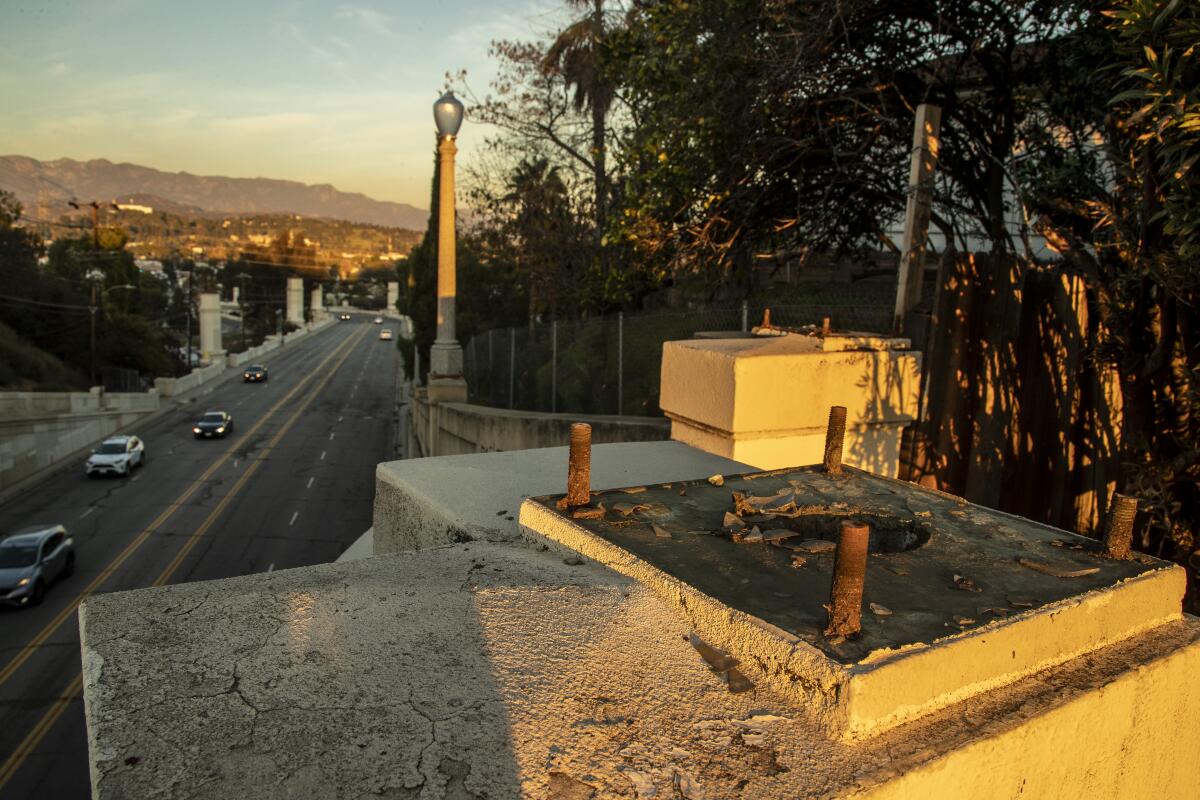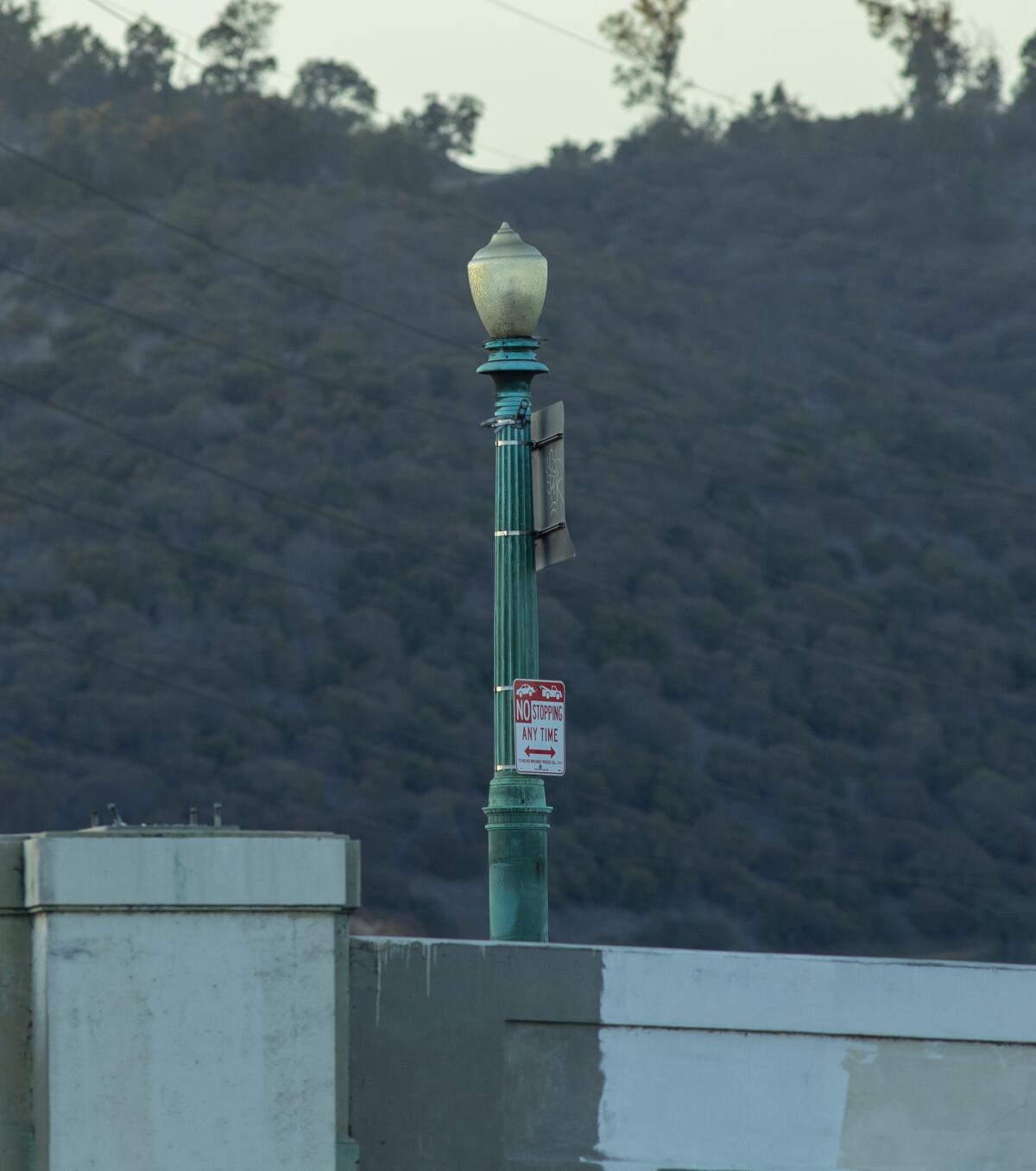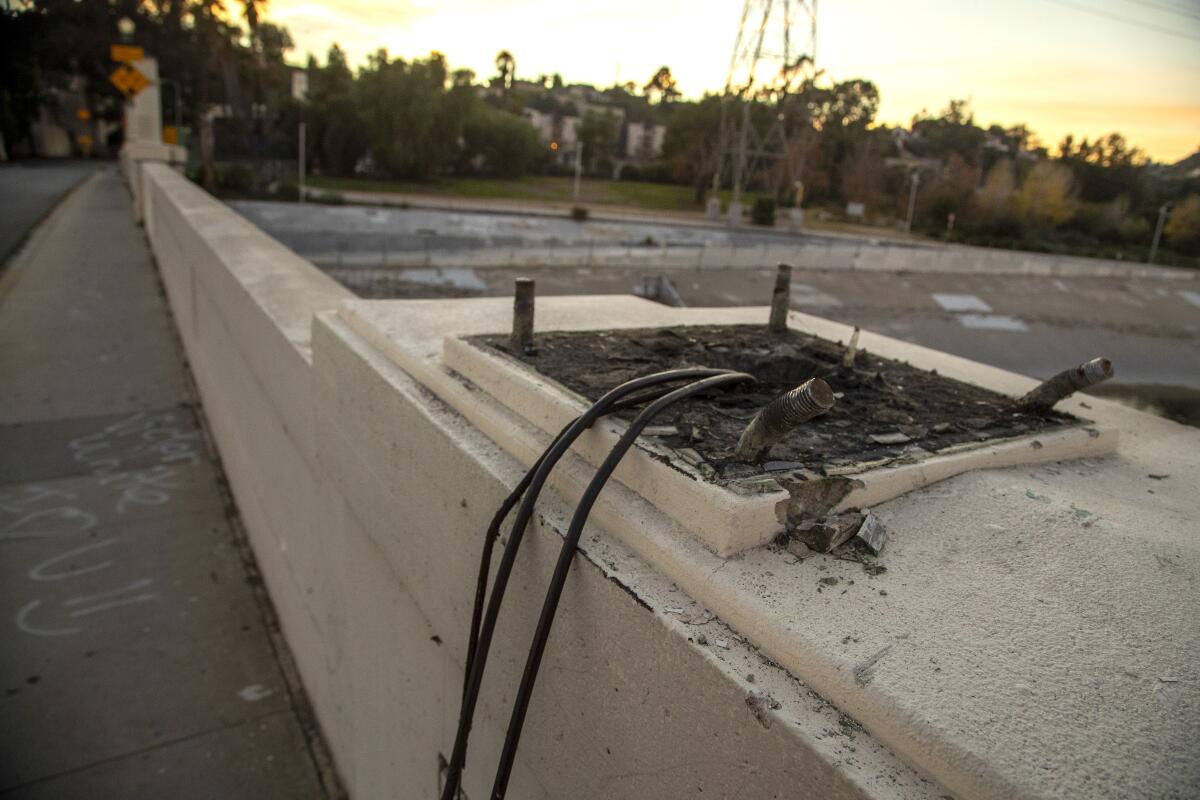Historic lamps are being stolen off an L.A. bridge. The city is removing the rest for safekeeping

- Share via
For nearly a century, dozens of silent sentinels have stood guard along the road between Atwater Village and Silver Lake.
Clad in the green patina of weathered bronze, the lampposts lining the historic Glendale-Hyperion Viaduct warded off the darkness that would otherwise engulf the spans.
But in recent months, several of the lampposts have been stolen, reportedly sawed down and hauled away by unidentified thieves, some as recently as this week.
According to the Los Angeles Department of Public Works, 22 of the historic streetlights are missing. City crews have taken down an additional 18 lights and stored them.
On Wednesday, after this article was initially published, the city announced it would remove and store all the remaining lights as a precaution, said Elena Stern, the department’s senior public information director. The fixtures will be replaced by temporary lighting.
“We believe there were/are roughly 60 to 70 historic lights along the bridge, which leaves about 20 to 30 lights left on the bridge,” Stern said. “Because the thefts have been continuing, preserving the remaining iconic lights is the right thing to do.”
The city’s Bureau of Street Lighting first learned of the thefts Sept. 18, Stern said. Three lights were reported stolen over three nights.
Crews went to inspect the bridge three days later and discovered seven lights missing, she said.

And the thefts have continued despite an ongoing Los Angeles police investigation. The most recent occurred sometime between Dec. 27 and Tuesday, Stern said.
The stolen lampposts were installed in 1926 and made of bronze, Stern said, and no replacements are immediately available.
“Replicas would have to be manufactured from scratch to replace,” she said. “The city is contemplating a future retrofit of the bridge for seismic and mobility purposes, which may provide an opportunity in the future to replicate elements that were stolen.”
For Glen Norman, a self-described streetlight historian who has been photographing and documenting historic fixtures in Los Angeles since the 1960s, the pilfered lampposts are more than a nighttime public safety risk.
“It’s just a tragic loss of some of the city’s history,” Norman said. “Old streetlights add character to the area. They’ve disappeared over the years. For me, as kind of a streetlight historian or detective, I like seeing the old lights because it gives me a sense of the L.A. that I grew up in.”
History hidden in plain sight
The Glendale-Hyperion Viaduct was completed in either late 1928 or 1929, “during the apex of all the World War I memorials going up around the country,” said Courtland Jindra, an amateur historian who served as a co-director of the California World War I Centennial Task Force.
It was among nine L.A. River bridges designed by longtime city engineer Merrill Butler and built in the 1920s and ’30s — along with those at 1st, 4th, 6th, 7th and 9th streets; Spring Street; Cesar E. Chavez Avenue; and Olympic Boulevard.
MERRILL BUTLER, MAN OF MODESTY, IS ELUDING US EVEN NOW.
One span of the Glendale-Hyperion Viaduct was dedicated as a World War I memorial on May 30, 1930, Jindra said.
Grand plans for a 3-acre park with a fountain and a proposed renaming of the Riverside Drive span to Victory Bridge never materialized, he said, but the memorial section is still visible today at the end of the Glendale Boulevard off-ramp from the northbound 5 Freeway. A large tree obscures a part of the inscription.
“It’s hidden in plain sight,” Jindra said. “You can read the Victory Memorial if you’re coming in the right direction. It’s just one of those things. Most people don’t look for it.”
For streetlight enthusiasts such as Norman, Los Angeles’ myriad aging lampposts are key parts of that history.
The city saw a big expansion in electric street lighting around 1924, when it started buying models from Union Metal, which is still in operation in Canton, Ohio.
“The ’20s were probably the golden age of the decorative streetlights in L.A.,” Norman said.

Jack Feldman, a retired L.A. Department of Water and Power engineer, has a personal connection to that history. One of his first jobs was in the department’s streetlight design section.
“I’m fascinated by how streetlights evolved from gas lamps on Main Street,” Feldman said. “How they produced the gas from La Brea Tar Pits and made the gas, how [Thomas] Edison came up with the lightbulb. Within two years all the major cities wanted them.”
Electric lighting in Los Angeles has evolved from the first 150-foot-tall streetlight poles that illuminated a whole block at a time into the ornate designs of the early 20th century and then the modernist and utilitarian fixtures that dominate most of L.A. today.
“If you’ve seen some of these, they’re beautiful,” Feldman said of the city’s classic lampposts. “It really identifies a time period in the history of L.A. when the city was growing.… Beautiful streetlights followed the wealthy areas and commercial areas.”
Today, Feldman runs a virtual museum for Water and Power Associates, a nonprofit organization focusing on energy and water issues, and on preserving L.A.’s regional water and electricity history.
A small L.A. artist collective beats out more than 100 entries from around the world with a “friendly” design that balances the past with the future.
Feldman and Norman were both saddened by the continuing loss of the Glendale-Hyperion lampposts.
“It’s very, very sad, very angering actually,” Norman said. “I can see why someone would do it for the meltdown value, but I just can’t see how someone would do it.”
Feldman said he wasn’t shocked by the thefts but feels the lights’ loss nonetheless.
“When you light up the streets, there’s a purpose for it,” he said. “It’s illumination, crime deterrence.”
But streetlight design was an art form at one time, Feldman said, and although the lights on the Glendale-Hyperion Viaduct were not as ornate as others around the city, he and others recognize their significance.
“It’s a work of art,” he said. “It all goes together. It’s part and parcel of the history of L.A. It’s just a shame [the thefts] happen.”
Community presses for answers
The Bureau of Street Lighting is continuing to work with police on the thefts, said Stern, the Department of Public Works spokeswoman.
It is also working on measures to protect the remaining lights and ensure public safety, she said. Though the stolen streetlights could be replaced in a future project, the 14-foot and 17-foot fluted bronze poles are not used anywhere else in the city.
Police were not able to answer questions from The Times on the exact timeline of the thefts and whether any suspects have been identified. Anyone with information about the thefts can submit an anonymous tip by calling Crime Stoppers at 1-800-222-8477.
Dan Halden, a spokesman for City Councilmember Mitch O’Farrell, whose district includes Atwater Village, called the Glendale-Hyperion Viaduct a beloved part of the community and a historic resource.
“Councilmember O’Farrell applauds the Bureau of Street Lighting for its efforts to proactively safeguard a number of lampposts on the bridge, and for partnering with the Department of Water and Power to install temporary lighting,” Halden said.
Meanwhile, Silver Lake and Atwater Village residents, along with a community of L.A. history enthusiasts, are continuing to press authorities for answers.
“People are stealing these, but who’s buying them, which metal yards?” asked Richard Schave, who along with his wife, Kim Cooper, runs the L.A. tour company Esotouric. “I don’t know what the solution is. I’m glad [the Bureau of Street Lighting] has taken some down, but it’s dark. The streetlights are out everywhere.”
A fixture we barely notice has the potential to help us deal with climate change and rebalance the city toward people rather than cars.
Late on the first Monday of 2022, a handful of cars drove across the viaduct.
The bright streetlights and cheery neon signs of Atwater Village lay behind. Ahead, many lampposts were missing.
All but a few of the historic lights were out, and the fading beams from fixtures near the bridge failed to illuminate the way on a bridge cloaked in darkness.
More to Read
Sign up for Essential California
The most important California stories and recommendations in your inbox every morning.
You may occasionally receive promotional content from the Los Angeles Times.











